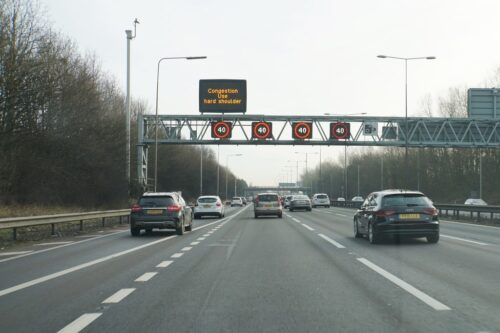
Whether you’re only an occasional driver or a regular long-distance commuter, it’s highly likely that you’ve enjoyed or endured motorway driving at some stage during your life, with 69 billion vehicle miles clocked up on Great Britain’s major roads in 2018 according to the Department for Transport.
Great Britain’s motorway network spans 2,300 miles and millions of us use it every day, which means it’s absolutely vital that we all practice safe motorway driving. Following these tips on how to drive on the motorway, hopefully, our roads will become a safer place for everyone.
As well as suggesting some basic motorway driving tips, we’ll examine whether smart motorways are safe and look at some of the best cars for motorway driving.
General motorway driving rules
It’s essential to understand how to drive safely on the motorway, and the Highway Code has a number of laws designed to protect all road users. Here are the key motorway driving rules:
- Stick to the speed limit. For most motorway driving this will be 70mph, but keep an eye out for notices of variable speeds, for example where roadworks are in place.
- Keep to the left-hand lane unless you are overtaking another vehicle. Once you’ve passed that vehicle, return to the left.
- Give other drivers plenty of notice by indicating well in advance when changing lanes.
- Check your mirrors regularly. With multiple lanes and vehicles travelling at higher speeds, changes can happen in the blink of an eye, so keep checking your rear-view and wing mirrors as well as your blind spots to practice safe motorway driving.
- Give yourself enough time to stop in the event of the car in front braking suddenly. If it’s dry weather, this should be at least two seconds, and in wet conditions, you should allow for at least twice that amount.
- Use the hard shoulder only in emergency, unless signposted otherwise.
- Take regular breaks, especially on long journeys. Stop off at the motorway services, stretch your legs, visit the toilet and grab something to eat or drink before getting back behind the wheel.
The above are just some of the most basic motorway rules. They may seem obvious, but by sticking to these guidelines, you’ll be protecting both yourself and other drivers.
Are smart motorways safe?

Attribution to ©Bill Boaden - https://www.geograph.org.uk/photo/5251763
The idea behind smart motorways in the UK is to keep traffic moving smoothly via the use of variable speed limits, lane closures or the opening of the hard shoulder as an additional lane. They use CCTV, sensors and radars to analyse all the information and respond in real time so that drivers can be updated as quickly as possible.
A recent report on smart motorways from Highways England returned mixed results. It showed that, in some cases, the number of serious collisions had increased – and Transport Secretary Grant Shapps has admitted he is “greatly concerned” by the number of incidents on the UK’s roads.
However, it was also revealed that the number of fatal accidents had fallen on six of the eight roads studied, while slight collisions were also less frequent. The government has recently announced plans to improve safety on smart motorways in the UK, while Highways England has published guidance on how to drive on a smart motorway.
How to gain confidence driving on motorways
Many people have a fear of motorway driving, so if that’s you, you’re certainly not alone. With a greater volume of traffic and vehicles travelling at higher speeds, it’s easy to see why a lot of people don’t feel comfortable on major roads. Here are a few motorway driving tips to help you become more confident:
- Travel with someone who is calm and assured in their motorway driving. They can guide you and offer helpful advice
- To get used to how junctions and slip roads work, you could practice getting on and off the motorway during quieter periods
- If your exit junction is approaching, get into the left-hand lane in plenty of time so that you’re ready and in position
- If you do miss your exit, don’t worry! Continue to the next one and come off there before re-orientating yourself
- When you join the motorway, stay in the left lane and get used to the speed of traffic before you think about overtaking
- Don’t be too tempted to stick only in the left or middle lanes. Driving too slowly can cause problems, and overtaking when needed will help to increase your confidence
It’s only natural to have a fear of motorway driving – plenty of people up and down the UK feel exactly the same way – but by gaining confidence you’ll soon become a better driver.
The best cars for motorway driving
Motorway driving can feel like a real chore to many, but that doesn’t have to be the case if you have the right vehicle for the journey.
What is the most comfortable car for motorway driving?
If you have a particularly long trip ahead then perhaps you’ll want to prioritise comfort, in which case the Audi A6, BMW 5 Series or a Mercedes-Benz S-Class can deliver this quality in spades. Their smooth, elegant rides mean you’ll feel perfectly at home behind the wheel, even if the traffic isn’t moving as swiftly as you’d like.
What is the most reliable car for motorway driving?
The last thing you need is to suffer a breakdown when you’re heading to work or taking a trip to visit some loved ones. Of course, sometimes issues crop up that are out of anyone’s control, but the Lexus GS, BMW 4 Series and Toyota Yaris are some of the more reliable cars and therefore less likely to let you down.
What is the safest car for motorway driving?
Everyone wants to feel safe on the roads, whether that’s on the motorway or on winding country lanes, and models like the Toyota RAV4, Lexus UX and Mercedes-Benz B-Class are at the top of the tree in this regard. In the driver’s seat of one of these, you’ll be able to take on any journey with that all-important peace of mind.
What is the most economical car for motorway driving?
If you’re someone who clocks up thousands of miles of motorway driving over the course of the year, you’ll be looking for the most fuel-efficient cars on the market. If that’s the case, models such as the Toyota Prius, Audi A4 or Toyota AYGO are ideal. They all offer superb MPG capabilities – good news for both your bank balance and the environment.
The best car for motorway driving really depends on what you’re looking for in a vehicle, but there’s certainly no shortage of options. Whichever model you choose, following some of our basic motorway driving tips will help make the roads a safer place for yourself and everyone around you.
You might also like
Best Motorway Services in the UK
Our Top Tips: How To Drive Safe in Europe
6 Bad Driving Habits Costing You Money
Visit our YouTube channel where you can find more safety tips and expert advice.



